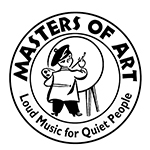What is a ‘Songstory’?
‘Songstory’ is a new form of narrative music that I have been developing over the last fifteen years. I did this to fulfil the personal need I felt to find a new and artistically satisfying way to tell extended stories using words and music. Telling stories with music seems to me to be a very worthwhile thing to do.
In many respects I am a child of the ’60s, and my musical roots are typically those of my generation; in chronological order, I loved Jazz, then R‘n’B, followed by Beat Music and Psychedelia. In the late ‘60s, I was a wannabe rock musician and, despite showing no evidence of any talent, I still bought into the belief that ‘our’ music could aspire to the artistic credibility and intellectual substance of ‘serious’ music. Somehow this High Art vision of rock music became linked inextricably in my mind with my own personal preference for the ‘long songs’ that began to be heard around this time.
The three-minute pop song is an utterly admirable artform. However, it has been defined and enforced, by an all-powerful music industry, as being the unit-of-choice in which non-classical music is to be marketed and delivered. The other familiar unit of ‘popular music’, the ‘album’ (whether LP or CD) may contain a larger amount of music, but in the great majority of cases, albums are simply collections of short songs.
Nonetheless, long songs have penetrated the charts quite regularly over the years; ‘Bohemian Rhapsody’, ‘Music‘, ‘MacArthur Park’, ‘Mr Blue Sky’, ‘Wuthering Heights’ and so on. I loved them all. From the late ‘60s, longer tracks also began to feature on albums (‘Atom Heart Mother’ and ‘A Plague of Lighthouse Keepers’ set the benchmark of excellence for me in this genre) and ‘Concept Albums’ began to be offered, where the entire contents of the LP make up a single narrative of some kind.
The absurd term ‘Concept Album’ has always annoyed me. (If you record Bach’s B minor Mass, you have a Concept Album, and Verdi’s ‘Otello’? Wow, that makes a Concept Double-Album…) Most rock music ‘Concept Albums’ are in fact Song Cycles. One song after another, all different, which are linked by their lyrics to convey some sort of unified story or message; the ‘concept’.
The Song Cycle is a perfectly respectable form, and it attracted me at the time. One of the first pieces of serious work I ever did is my ‘Requiem Mass’ of 1974 (which as I write is still unperformed and unrecorded, except for a rough fragment to be found on the ‘Democrazy’ CD). This is essentially a heavy-rock Song Cycle, with its lyrics being the Latin liturgy for the Mass of the Dead.
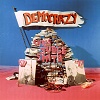
I was also writing ‘short songs’ throughout this period, something I’ve continued to do throughout my life, but most of these were ‘story songs’. I have found little to add to the various standard love-song formulas that underpin most popular music. (I should point out that I’ve always been very keen on ‘lurve’ in its various forms; I’m just seldom inspired to write songs about it.) Increasingly, I realised that my strengths lay in constructing narratives, and the music to go with them.
We have a primitive need for stories and music. The arts of music and storytelling probably developed together around the end of the last ice age. Someone dipped their hands in natural ochre and started making patterns on the walls of the cave, someone else began to tell tall tales about last season’s hunting, and someone else found that rhythmically thumping a mammoth skull with a couple of sticks made a great sound, and girls thought you were cool. The first poems were probably the lyrics of songs and the earliest Epic narratives are believed to have been originally sung to music.
Over the centuries, Narrative and Music have developed an uneasy but passionate relationship with each other. They are complimentary opposites, Yin and Yang. Narrative is quantitative, music is qualitative. Narrative makes a statement and music determines how you feel about the statement. Narrative and Music have come together to make art in many varied combinations, and I tried my hand at several established forms of narrative music before developing my own variety.
 I followed the ‘Requiem’ with a second Song Cycle, ‘The Kibbo Kift’, written this time in collaboration with Maxwell Hutchinson, who provided the music, with myself as lyricist.
I followed the ‘Requiem’ with a second Song Cycle, ‘The Kibbo Kift’, written this time in collaboration with Maxwell Hutchinson, who provided the music, with myself as lyricist.
‘The Kibbo Kift’ was intended to be an audio piece (we may have even thought of it as a Concept Album) existing in a recorded form only (if and when we ever managed to get it recorded) and it was completed as such in 1975. As things turned out, we were persuaded (quite easily) to add some stage business to the lyrics, and to allow it to be produced on stage as a Rock Musical, in which everything was sung and there was no dialogue. This introduced me to the world of Stage Musicals, a world in which I lingered for too long, I now feel.
As a Song Cycle, ‘The Kibbo Kift’ was quite forward-looking in a structural way. Some songs represented particular situations and emotions of the narrative, and when those situations and emotions reoccurred in the story, the same tune came back, with different lyrics. This is hardly an original idea, but it works well, and only a minority of Song Cycles seem to play with it.
I was now fully committed to storytelling with music, and doing it on a bigger scale than the one-off short song. ‘The Kibbo Kift’ was well received and Maxwell and myself were offered the opportunity to write something else for the stage. We were to write a further two Musicals together, both of them rather more traditional as regards structure and technique. In both, scenes of spoken dialogue alternated with songs and instrumentals; in other words, we were using the standard building-blocks of the conventional Stage Musical.
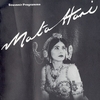 The Stage Musical can be a very satisfying way to tell a story with music, and I would go on to collaborate with Lene Lovich and Les Chappel in 1981 to write ‘Mata Hari’, a Musical that was somewhat less traditional in that I tried to cut spoken dialogue down to a minimum (Lene, as Mata Hari, never spoke). The remaining sections of speech were set to music, and the result was a smoother and more stylised variety of Musical, without the naturalism of normal spoken dialogue.
The Stage Musical can be a very satisfying way to tell a story with music, and I would go on to collaborate with Lene Lovich and Les Chappel in 1981 to write ‘Mata Hari’, a Musical that was somewhat less traditional in that I tried to cut spoken dialogue down to a minimum (Lene, as Mata Hari, never spoke). The remaining sections of speech were set to music, and the result was a smoother and more stylised variety of Musical, without the naturalism of normal spoken dialogue.
However, a Musical only really exists on the stage, it is a variety of Drama rather than being an act of storytelling, and storytelling, in my view, should be complete as an audio experience. I realised that Stage Musicals were not the musical form I was looking for, and after ‘Mata Hari’ I wrote no more.
Before the (popular, low-brow) Musical existed, there was (elitist, high-brow) Opera, another honourable and fascinating form of narrative music. The defining characteristic of Opera is that the characters conduct their encounters and conversations entirely in song. In fact, that statement is not strictly true; some impeccably high-brow Operas include passages of speech, while some thoroughly low-brow Musicals have none. However, essentially we can say that, in Opera, people are singing at each other all the time.
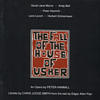 My experience as an Opera librettist is limited to a single work, ‘The Fall Of The House Of Usher’ by composer Peter Hammill, but my work on this piece stretched over a period of eighteen years. I remain very happy with the work, and I think the operatic convention of sung conversation was handled exceptionally well by the composer. However, over the years, I have felt more and more that there is something inherently alienating about listening to two people singing a conversation. It just seems unnatural to me, and I wanted to see if I could find a more naturalistic style of narrative music, if there could be such a thing.
My experience as an Opera librettist is limited to a single work, ‘The Fall Of The House Of Usher’ by composer Peter Hammill, but my work on this piece stretched over a period of eighteen years. I remain very happy with the work, and I think the operatic convention of sung conversation was handled exceptionally well by the composer. However, over the years, I have felt more and more that there is something inherently alienating about listening to two people singing a conversation. It just seems unnatural to me, and I wanted to see if I could find a more naturalistic style of narrative music, if there could be such a thing.
 My first attempt towards this was ‘The Book Of Hours’, which I composed, words and music, between 1977 and ’78. At the time, I referred to this piece as a Chamber Opera, though in fact it was really a proto-Songstory. The breakthrough I made in this piece was to give all the narrative to a single voice, who thus became a storyteller, telling his own story in words and music. There were a few interjections from other characters, but these were kept to a minimum. The music (for String Quartet, Bass Guitar and Drums) was more free, and less bound by conventional song structures, and I began to move towards a style of composition that could incorporate many different, contrasting sections of music.
My first attempt towards this was ‘The Book Of Hours’, which I composed, words and music, between 1977 and ’78. At the time, I referred to this piece as a Chamber Opera, though in fact it was really a proto-Songstory. The breakthrough I made in this piece was to give all the narrative to a single voice, who thus became a storyteller, telling his own story in words and music. There were a few interjections from other characters, but these were kept to a minimum. The music (for String Quartet, Bass Guitar and Drums) was more free, and less bound by conventional song structures, and I began to move towards a style of composition that could incorporate many different, contrasting sections of music.
 Lyrically, however, ‘The Book Of Hours’ was quite conventional. The lyrics rhymed, like the bulk of my previous work. Over the years I have become quite adept at turning a good rhyme, and I have a certain professional pride in this skill. However while I was planning my next large-scale narrative piece in 1993, I considered the idea of abandoning rhyme altogether, and I experimented with the technique on a short song called ‘We’ll Always Have Paris’ (eventually to be recorded, years later, on ‘The Full English’ CD). The results were extremely interesting.
Lyrically, however, ‘The Book Of Hours’ was quite conventional. The lyrics rhymed, like the bulk of my previous work. Over the years I have become quite adept at turning a good rhyme, and I have a certain professional pride in this skill. However while I was planning my next large-scale narrative piece in 1993, I considered the idea of abandoning rhyme altogether, and I experimented with the technique on a short song called ‘We’ll Always Have Paris’ (eventually to be recorded, years later, on ‘The Full English’ CD). The results were extremely interesting.
I realised that, if I could write music with lyrics that neither rhymed nor scanned (i.e. did not have a regular or predetermined number of syllables per line), my language could be far more naturalistic and subtle, and most important of all for someone wanting to tell stories, I could get information across very much faster. If it takes fifty words to get across a piece of information in prose, it probably takes more than four times that number to do the same job in rhyming verse.
Structured verses of lyrics lead to structured verses of music, and visa versa. They reinforce each other. It doesn’t matter which is written first; take away structure from one and the other must become unstructured to match.
However, as a Rock composer, any advantage of using ‘free’ lyrics would be worthless to me if the only music that worked with them would be plodding drone-music that didn’t do anything or go anywhere, and just as worthless if they only worked with unstructured, non-rhythmic, avant-garde-type music.
I was pleased to find, by trial and error, that the standard vocabulary of Rock Music; rhythms, riffs, bass lines and chord sequences, worked just fine without structured stanzas of lyrics. The secret was to approach the melody line, the tune that the lyrics would be sung to, as if it was an instrumental solo for a guitar, organ or sax.
Improvised instrumental solos are one of the great glories of Rock, Blues and Jazz (in fact famous Jazz solos have sometimes had lyrics written for them, to turn them into songs) and I found I was able to write vocal melody lines for my unstructured lyrics that sounded as if the singer was making them up on the spot, improvised over the music. The melody lines were also free to follow the emotional nuances of the lyrics, and the natural inflections that a voice might make if it was speaking the lines instead of singing them.
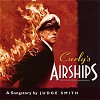 It was with this basic technique of words and music that I started to write the giant piece, ‘Curly’s Airships’. Halfway through the seven year process, I thought that this new musical form deserved a name, and my friend John Ellis, guitarist on the project, came up with a winner; ‘Songstory’.
It was with this basic technique of words and music that I started to write the giant piece, ‘Curly’s Airships’. Halfway through the seven year process, I thought that this new musical form deserved a name, and my friend John Ellis, guitarist on the project, came up with a winner; ‘Songstory’.
I now had a few axioms or rules to work with: the Songstory is essentially told or sung by one voice, who ‘speaks to the camera’. There can be other voices, but they also address the listener directly. Dialogue is avoided wherever possible. The text is unrhymed and not metrical; but an exception is made for songs that are performed, as songs, as part of the story (for example, a record might be heard playing on the radio, or characters in the story might perform a folk song, and so on).
If these rules are the bricks and mortar of a Songstory, there also needs to be some architecture. Songstories are, by their nature, quite long, and need a structure, some sort of larger scaffolding to hold them upright.
Classical Music also deals in long pieces; much longer than is usual in the worlds of Rock or Pop, and over the centuries, elaborate structural systems of Classical composition have developed; sonata form, concerto grosso, symphonic forms of various kinds, and so on. These noble systems were not really available for me to use; in some cases because they would be simply inappropriate for Rock music, but also, frankly, because of my lack of musical education. The formal ‘Exposition, Development and Recapitulation’ of my musical themes would be quite beyond me. However, I have been pleased to discover that my basic rules and building-blocks of Songstory, that I outlined above, seem to be robust enough to work with a variety of structural schemes or systems of my own.
In ‘Curly’s Airships’ (2000) I used representative themes or leitmotifs as the structural elements. (This, of course, is also a Classical composition technique, but one which even I could understand.) Characters in the story and particular recurring situations each had their own tune or riff. In the finished work there were 27 of the things, perhaps rather more than most listeners would be able to recognise when they were repeated, as I now realise.
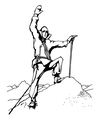 In ‘The Climber’ (2010) on the other hand, a much shorter Songstory about an British mountaineer climbing in the Italian Alps, I used a different structural system. The work features a chorus who give their own side of the story, in parallel with the main character giving his. This chorus (a male voice choir) who represent villagers, hotel staff, mountain guides and so on, hardly ever communicate with the protagonist, but they address the listener directly. Their text also includes several actual ‘songs’ for the chorus with rhyming, metrical lyrics, in contrast with the strict ‘Songstory-style’ narration of the Climber himself.
In ‘The Climber’ (2010) on the other hand, a much shorter Songstory about an British mountaineer climbing in the Italian Alps, I used a different structural system. The work features a chorus who give their own side of the story, in parallel with the main character giving his. This chorus (a male voice choir) who represent villagers, hotel staff, mountain guides and so on, hardly ever communicate with the protagonist, but they address the listener directly. Their text also includes several actual ‘songs’ for the chorus with rhyming, metrical lyrics, in contrast with the strict ‘Songstory-style’ narration of the Climber himself.
For ‘Orpheus’, the most recent Songstory, I have chosen a third system to make a scaffolding for the piece: the use of different and contrasting types of music and groups of instruments, There are at least seven entirely separate instrumental and vocal groups on the album, each playing a very different type of music. An Instrumental Rock Band, a String Sextet, Classic Trance, a Death Metal band and Flamenco Guitar are all featured, amongst others, each covering a specific aspect of the story.
I would be amazed if any of my music-making techniques were unique or original. A multitude of other writers make unstructured, unrhymed lyrics; a host of Rock composers make melodies that don’t follow a set pattern, or compose long pieces with multiple sections of contrasting music. My slow progress towards Songstory (I’m trying not to use the word ‘journey’ here) is important and significant only to me. Perhaps even writing about it is a futile exercise, and adds nothing to the enjoyment (or otherwise) of actually listening to the stuff.
Narrative music takes a long time to do, and I am certainly not the most facile or swift of composers. However, if I am given the time, there will be other stories that I would like to tell, and when that time runs out, I suspect that, if I am to be remembered at all, however briefly and by however few, it will be for my work in this Songstory form.
January 2010
